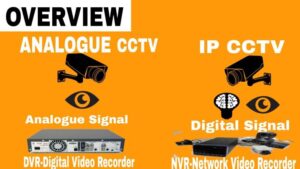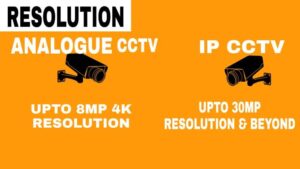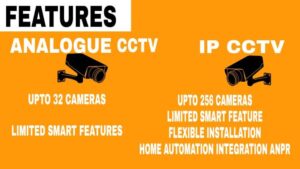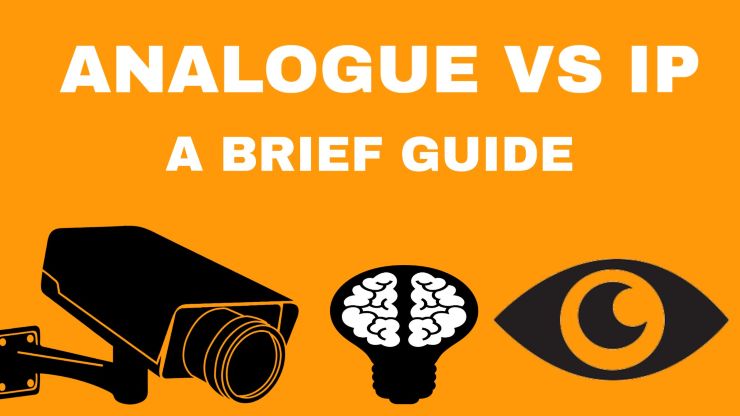Misconceptions
This is a brief guide on Analog VS IP CCTV so if you’re looking at purchasing a CCTV system some misconceptions about both standards that is both systems both analog and IP will allow you to remotely monitor your system on a smart phone they both record on a digital hard drive and they can both produce up to 4K 1080P High Definition images.
OVERVIEW

- If we begin with an overview analog CCTV is like having an eye connected to a recorder that is it only provides visuals and hence it’s an analog sent usually via a coaxial cable known as an RJ 59 which we’ll discuss a bit later and that gets plugged into what’s known as a DVR or a digital video recorder and you can see at the back of this illustration we have the standard BNC connectors and on the left hand side you can see an RJ 45 connector and that would be for your broadband router in order for you to be able to watch the cameras on your mobile phone.
- Now this is a simple way to understand IP CCTV and how it differs from analog now in addition to having visuals recorded think of an IP camera as a brain it’s an eye plus a brain and it’s sending a digital signal back to the recording box so if you can imagine it’s actually sending zeros and ones you’ve got information being sent rather than an analog signal now what that means is the brain can do extra work for you so for example in more complex systems where you’re trying to record number plates only an IP system would allow you to actually extract that data whereas an analogue camera although it might be able to see a picture or a number plate it would not be able to extract that data the way an IP camera would plug into a recorder known as a network video recorder or NVR you can see on the illustration on the bottom right hand side that you’ve got an RJ 45 connectors which you might be used to on your laptops and PCs because that’s how the cameras interface with a recorder.
Resolution

- We compare the resolution both systems can actually do 8 megapixel which is a 4K high-definition and we get a lot of questions from people who think analog is restricted to non HD which is not true analog can actually go up to 8 megapixel which is a 4K resolution and the type of signals you might hear off our HDTVI, HDCVI and a HD now these are the protocols that are used to send a high-definition signal over a cable.
- An IP system well you can actually go beyond in there’s a company’s making cameras going up to 30 megapixel and beyond so if you’re looking for very high in resolution well 13 megapixel is something you’d might see in a casino or a military base as perhaps not something you need to worry about if it’s for a domestic installation but it’s worthwhile knowing this.
CABLE

- If we jump on to the cable analog CCTV uses coaxial cable which is actually a traditional type of cable used in the CCTV in history you might recognize this connector it’s known as a BNC connector and you’ll also hear of a DC connector which is their power connector the camera would often have other names for the coaxial cable is RJ59 and power or siamese and shotgun cable now the reason it’s called Siamese or shotgun is because you’ve got two cables joint together worthwhile noting there is a distance limitation on this cable of about 50 meters and that’s due to the power signal you can actually run the video or around 150 meters but then you would have to power the camera locally.
- If we jump on to IP systems IP systems use a CAT 5e or a CAT 6 cable which is usually an UTP which is unshielded twisted-pair and you’ll know in larger buildings you will already see this type of instructor use for the networking of computer systems so it uses the same type of cable and the connector is known as an RJ 45 you don’t usually have a power connector separate because the RJ 45 carries power and that’s known as power over Ethernet and you can actually get systems now that can go up to about 250 meters that means you can run a 250 meter CAT5e cable and plug a camera all the way back to the NVR over that single cable whereas analog CCTV would not allow you to do that unless you start powering locally that means having a local plug next to the camera.
FEATURES

- Analog CCTV on a single recorder you can have about 32 cameras now if you remember just on the first slide we were talking about the cameras being like eyes that’s exactly what it’s like and so you’re a bit limited in terms of the smart features that you can integrate with that system that being said most people only need to watch they’re recording in a decent resolution in a high definition resolution and have mobile phone access and some of the more basic features so this an analog system isn’t usually sufficient for most applications.
- IP CCTV is a lot more cable and we’re going to show you a little diagram in a bit to show you what that looks like in a physical installation but a single network video recorder can go up to 256 cameras and IP system is a lot more flexible and again we’re going to show you that in its little diagram now they’re smart features you do actually have a lot more smart features compared to analog there’s a little mistake there I should actually say advanced smart features so for example you know let’s say you wanted to record number plates well an IP system would allow you to do that or let’s say you wanted to integrate your cameras with a home automation system that would also allow you to do that whereas an analog system is kind of restricted and again this goes back to the IP camera being an i plus a brain they’re like smart devices you can call them and so you’ll see some of the larger companies like Google Nest and rings camera and there are the various other brands like that they are generally all IP cameras which would interface with your broadband router whereas an analog system would require if you can imagine an eye being plugged back into a recorder.
Installation
- Now this is just to show you give you a sort of installation I guess when you’re scaling up with an analog system you are restricted in the sense that your cabling can start to get a little bit messy and that’s because each camera which requires a video signal going back to the recorder so in this example where you’ve got a second building imagine you wanted everything controlled on one recorder you would have to run back 16 cameras all the way back to your recorder.
- If you compare that to an IP system because it’s based on networks which are addressable you could essentially have one cable go into a second building you could then fit a IP switch and from there you could add your 16 cameras now you can imagine doing much larger installations let’s say in schools or casinos and larger public buildings where IP systems would make more sense than analog.
Benefits
- I seem to have been bashing analog CCTV quite a bit but it’s not true there’s there are a lot of advantages that analog CCTV has one of them is very low maintenance and that’s because the cameras are to some degree a lot more simpler than IP they don’t have complex brains taken and IP signals so your technical knowledge required for installation is a lot simpler than IP systems generally you’ll find some of the more cheaper systems are analog CCTV and the other thing is if you can imagine you’ve already got a system that you want to upgrade so High Definition if you have existing cabling like coaxial or shotgun cabling then it would make more sense to utilize the existing cabling and upgrade to High Definition rather than running new wiring the other advantages you have are there is actually a new system known as power over coax that means you would not need to run the shotgun cable you can run a single video cable so have a look out for POC which is it’s been around for actually a very long time but we’re seeing it creep back up and that’s because the manufacturers have found away to send High Definition signals over a single cable and the other advantage there is you can run up to 200 meters so that the where previously you were restricted on power up to about 50 meters you can now run up- 200 meters the other advantage with analog systems is a lot of the recorders now they do have hybrid features which actually allow you to add IP cameras at a later date if you require.
- IP CCTV so it works with existing CAT5e wiring if that’s what your office saw or school has it’s a lot more scalable as we showed in the previous diagram that means you can add and take away cameras without having to rewire much you can just use the network infrastructure to do that you’ve got home automation integration so for example let’s say you’ve got a control for or AK restaurant system you could use IP cameras and integrate them into your single smart device there are a lot more smart features on IP CCTV it’s a lot more flexible but it does require a little more technical knowledge now I’m pretty sure any of you who are searching you will find plug-and-play systems and that’s very well but if you are looking to deploy more advanced systems you are required to have a little bit of more a little bit more technical knowledge compared to analog CCTV.
Example

- Now we’re going to give you a little example of a like-for-like comparison so if you have a look at these visuals you can see left and right left we’ve got an analogue system and right we’ve got an IP system now we’ve chosen the same camera model for this they’re both 8 megapixel at 4K resolution and on the left-hand side you’ve got the analog system which if you can imagine is like having an eye now I can see the number plate as you can see from the image there without a problem.
- But on the right hand side you’ve got an IP system which is like an eye plus of brain now what’s the difference the IP system because of its digital capture allows the footage to be interpreted and the data extracted now that means you could essentially extract a list of all the number plates that on let’s say a gate or a barrier and actually give you a full log whereas an analog system would not allow you to do that although you could play back the footage and perhaps see the number plate you wouldn’t be able to extract the data out of it now the other thing IP cameras will tend to have these types of IP cameras anyway is a relay connection which you could plug into your barrier or let’s say a siren to automatically trigger so any of you who go to the airport you’ll notice as you as you as you enter the airport car park you will usually have your number plate captured by an IP camera and on your way out that’s usually connected to your gate system which allows the gate to open and that’s because it’s actually it’s extracting the data from the image that it’s seeing and that’s one of the main differences between an analogue and IP camera.
Now final question is which one do you want to go for which one is the right system for you I guess the first thing is it depends on is are you using it for a home or a business and just a few questions to ask yourself.
- what type of security needs do you require because both systems are good enough for high definition security and if you just want to keep an eye on your premises and you know you want to have the functionality to watch on your phone at your convenience well both systems can do that if you’re looking to deploy a system which already has cabling in place then it’s worthwhile University getting what cabling you have because if it’s coaxial and power it might save you a lot more money upgrading that system to a high-definition analog system versus pulling that all out and having to rewire it and vice versa if you already have CAT5e Ethernet cable in place then you might want to look at using that to up to basically put on an IP system on the existing infrastructure.
- what’s your budget generally analog systems are cheaper than the IP systems and if you’re on a budget then an analogue system might make sense what sort of features are you looking for do you require number plate capturing or home automation integration or any other smart features in which case you might want to start looking at an IP system are you looking to fit this yourself is this a DIY project if so have a look at both options most of the time if you if you’re getting a good deal guess that’s going to be one of your major factors but you might want to run that past some of the features above just to make sure you’re not missing out on anything.
Finally are you looking to future-proof your system do you think your security requirements are going to be exceed in about a couple of years in which case do you want to start what do you want to invest in a system that will allow that future expansion and just on that note if you are looking for let’s say a four camera system it’s always worthwhile going for a slightly bigger recorder let’s say an eight channel and that’s because in the future let’s say you moved house or in a business let’s say you move business and you wanted to add extra cameras you’re not then having to spend an extra couple of money on a new recorder you will have the capacity to add that so it’s all worthwhile thinking about the future when you’re looking at a system.
